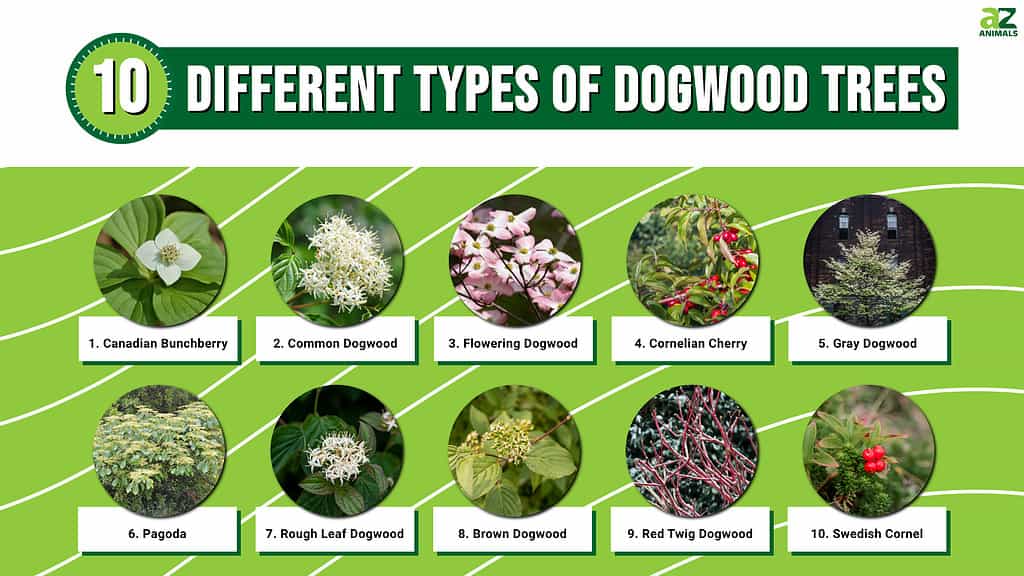
The Dogwood is an all-season beauty that thrives during summers and winters. This magnificent decorative tree is in the genus Cornus, consisting of flowering shrubs, woody trees, and some species of subshrubs.
Dogwood trees are common in different parts of the United States. They thrive well in a wet climate, and sunlight is essential for the survival of these trees. They also have a dense and fast-growing root system that requires the tree to grow on solid ground.
The color of your Dogwood tree depends on its species, and they have various characteristics. Some species grow into bushes, while others are deciduous moderates and evergreen. Here is everything you should know about Dogwood trees and the different types.
How to Grow a Dogwood Tree
Dogwood trees are a favorite of many gardeners because of their beauty, especially during the flowering season. They are also a favorite to many birds because they are a source of food and shelter.
While Dogwood trees are beautiful and every gardener’s desire, you need to plan well before planting them in your backyard. It requires certain climatic conditions to thrive well and enough space to grow its roots.
Before you dig its hole in the garden or pick the Dogwood plant you want, start by identifying a planting location. Ensure that your tree won’t be scorched by direct sunlight because this can discolor its leaves, which affects its glow.
When picking the location, identify places with some shade, but also ensure your tree will get direct sunlight. Remember that Dogwood grows into a big tree that will shade. So, don’t grow it near a plant that requires sunlight.
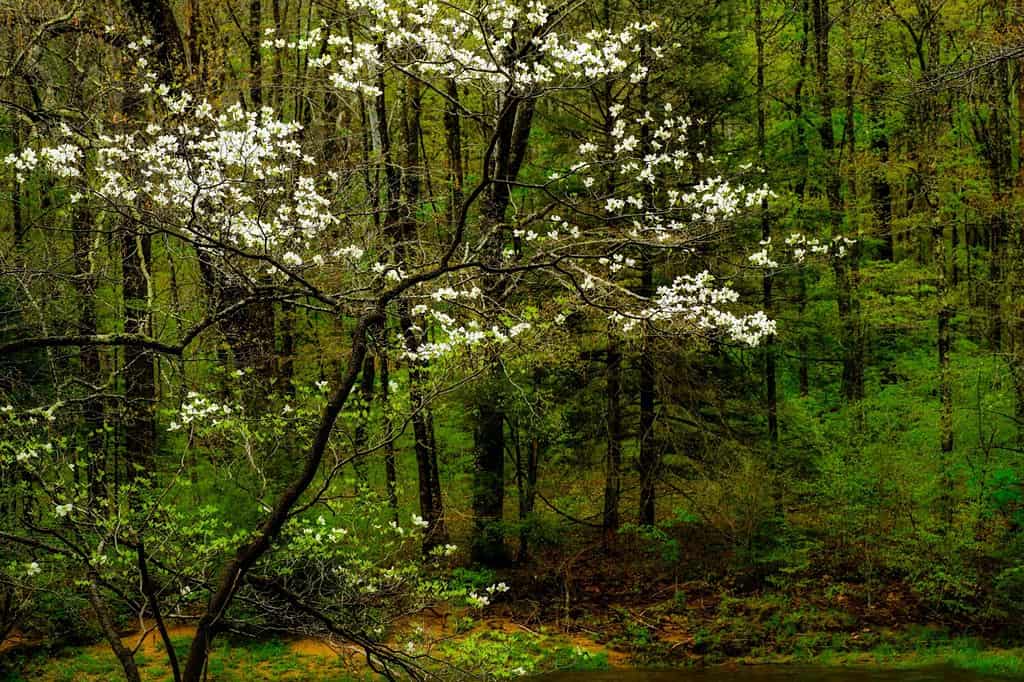
Wild dogwoods thread mountain trails with their lacy beauty.
©Malachi Jacobs/Shutterstock.com
Type of Soil to Grow Dogwood
Dogwood trees don’t do well in soggy soils, so you must ensure the soil drains. You can enrich the soil with organic material and ensure it is acidic. But, if the soil lacks the correct PH and organic material, you can add compost with coffee grounds.
Dogwood Life Span
Dogwood trees have a life span of up to 80 years. Planting them in your garden is a lifetime commitment. These trees are also easy to care for. Ensure you plant them in a location with adequate water and sunlight.
The tree can be used for decorative purposes and shade. Birds benefit from it because it provides food. If you move regularly, you can choose a Dogwood with a shorter life span.
Choose Your Dogwood Tree
Once you get a perfect place to plant your Dogwood, you can start choosing the tree you want to decorate your compound with. Dogwoods are available in different sizes. Some trees flower, while others bear fruits.
There are different flowering Dogwoods, producing flowers of different colors and sizes. These flowering Dogwoods are primarily common in the U.S. The Pacific Dogwood is common among the people who live on the West Coast.
Types of Dogwood Plants
Whether you want a shrub, an evergreen plant, or a flowering plant, there is a Dogwood for everyone. Some of the types of Dogwood you can grow in your garden are:
1. Canadian Bunchberry
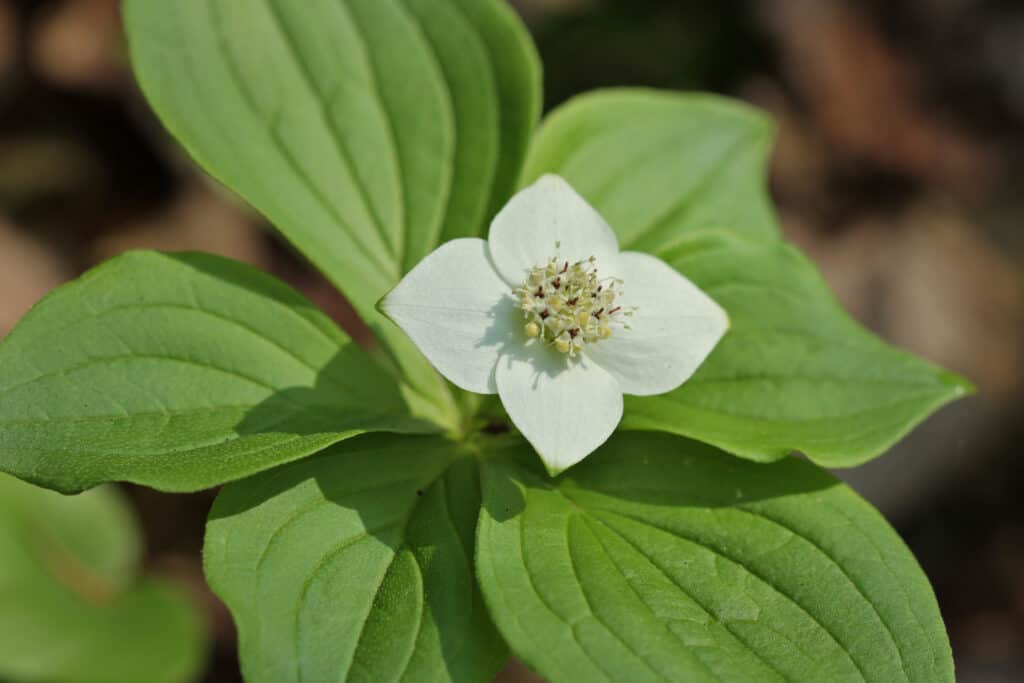
The Canadian dogwood, also called the Canadian bunchberry, grows mainly in North America, Greenland, and northeastern Asia.
©iStock.com/Yves Dery
Also known as the dwarf cornel, the Canadian Bunchberry is a Dogwood shrub. This tree spreads by rhizomes and can grow up to 4 to 6 inches. Its leaves are dark green, and they have prominent veins.
Most gardeners like its white flowers, which signifies that the plant will bear fruits in late summer. The Canadian Bunchberry grows mainly in North America, Greenland, and northeastern Asia, and its red fruits are edible.
2. The Common Dogwood
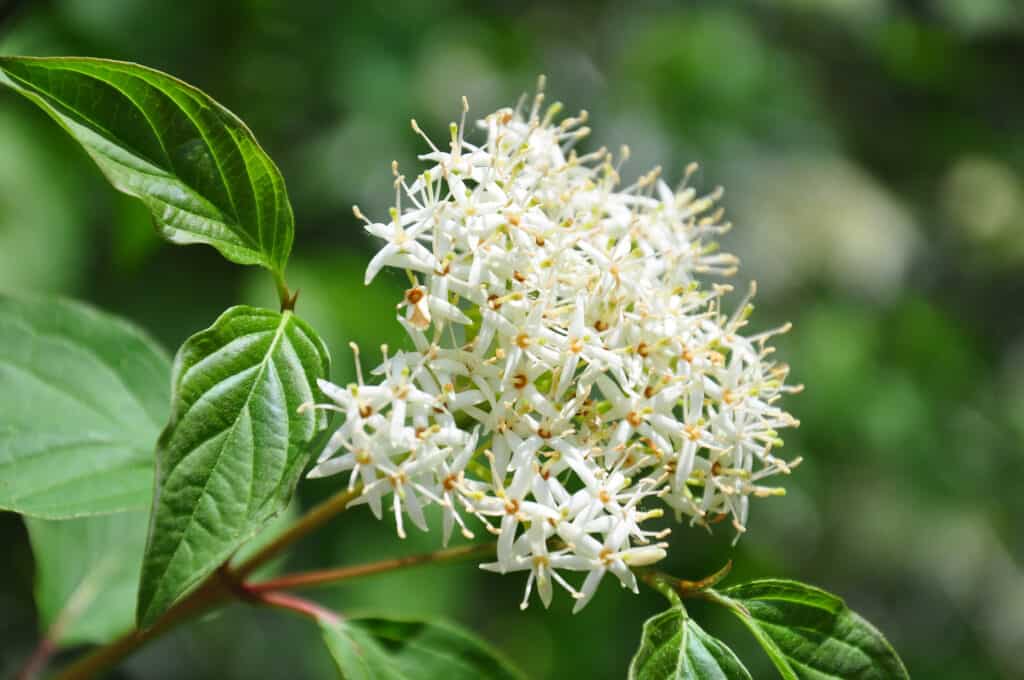
The Common Dogwood’s flowers are white, and the leaves are elliptical to oval.
©iStock.com/rbiedermann
If you are looking for beauty for your garden, Common Dogwood will be the right choice. This plant is primarily grown in Europe and Western Asia. It is a shrub with multiple stems and flowers in the late spring.
Common Dogwood’s flowers are white, and the leaves are elliptical to oval. The flowers turn into blueberries in autumn, but these berries are not edible. They are toxic to human beings. The tree is most beautiful in fall when the green leaves disappear, leaving it with a beautiful purple-red hue.
Common Dogwood plants grow to 8 to 15 feet, but some are dwarf. They require full sun exposure to grow perfectly, and gardeners must prune them yearly to maintain their shape and help the shrub spread.
3. Flowering Dogwood

The Flowering Dogwood is common in North Carolina. It’s characterized by low branches with a flattish crown, growing to 15 to 20 feet.
©iStock.com/JillLang
Gardeners obsessed with flowers in their yard can try the Flowering Dogwood plant. You will enjoy this plant’s look most during spring because that is its flowering season. The flowers are white or pink, and some are red.
The Flowering Dogwood is common in North Carolina. This plant is characterized by low branches with a flattish crown, growing to 15 to 20 feet. The red, pink, or red flowers turn deep red in fall, and they start producing fruits.
For your Flowering Dogwood to flourish well, ensure the soil is acidic and plant it under another plant that can offer shade. You should also prune the branches to avoid infections like Dogwood anthracnose.
4. Cornelian Cherry

By mid-summer, the yellow flowers of the Cornelian Cherry plant turn into beautiful and edible red cherries.
©iStock.com/RuudMorijn
People living in Europe and western Asia are privileged to have an attractive option of Dogwood plant, the Cornelian Cherry. It grows as a large shrub and flowers every year. During the early spring, you will notice beautiful yellow flowers.
By mid-summer, the yellow flowers turn into beautiful and edible red cherries. The cherries are harvested and used to manufacture jam, desserts, and sauces. The plant has oval foliage that measures 4 inches in length.
Cornelian Dogwoods are beneficial because their fruits are useful. These plants also bloom early, and they grow up to a height of over 15 feet. The plants sprout well when grown under the full sun but with some shade.
5. Gray Dogwood

Dogwood Tree Blooms With Bourbon Warehouse
©iStock.com/kellyvandellen
The Gray Dogwood spreads through rhizomes, and it grows to form thickets. The plant is beautiful and produces white flowers in spring, which grow into white berries during summer. The berries are attractive to all animals but only edible to birds.
The Gray Dogwood has dark-green leaves and grows to a height of 10 to 12 feet. The leaves turn purple-red in fall, and they get a new orange-brown bark each year, which ages by fading into grey. This plant is primarily common in Eastern North America.
6. Pagoda Dogwood
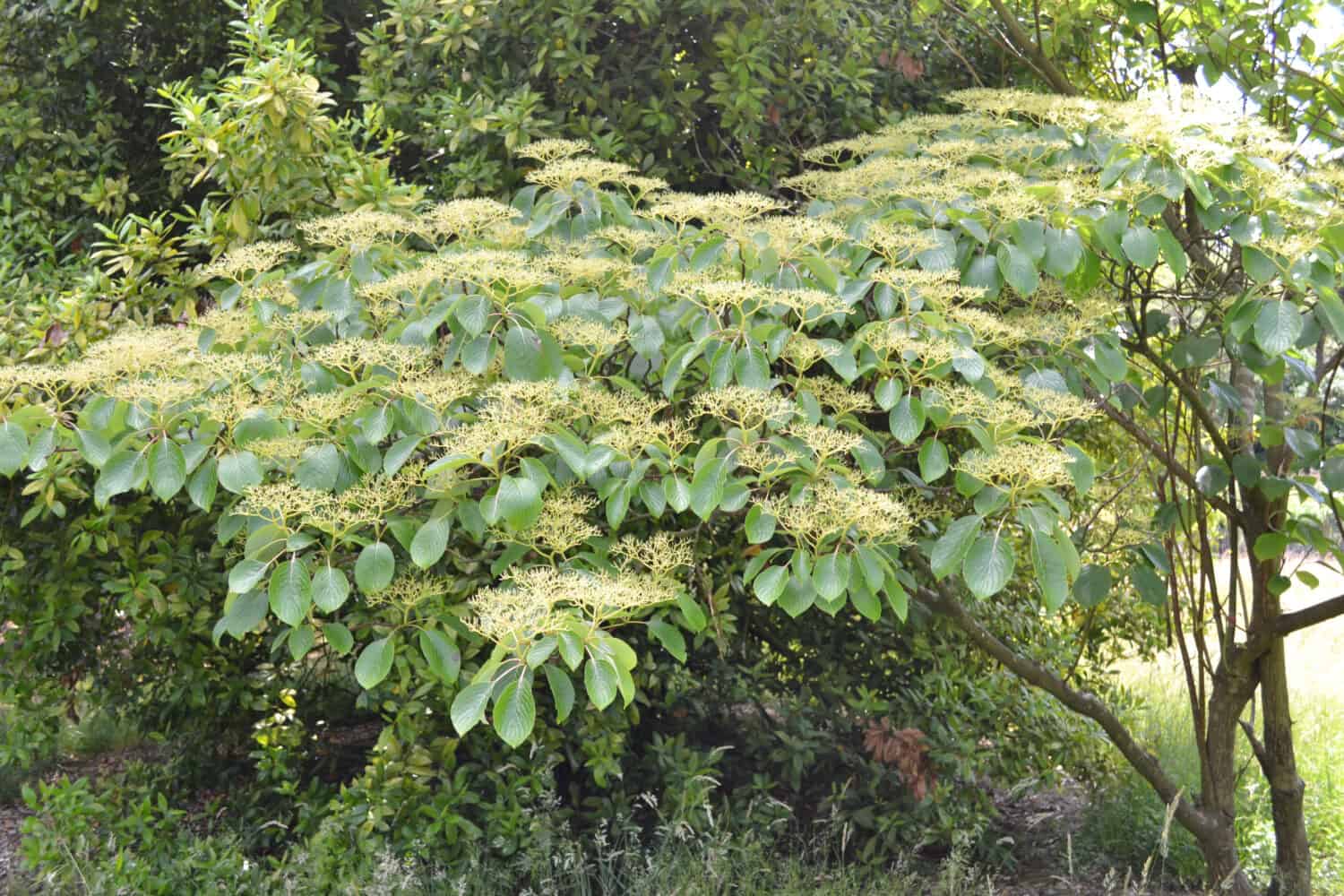
Pagoda dogwood is also called the wedding cake tree.
Image: Edita Medeina, Shutterstock
©Edita Medeina/Shutterstock.com
Another Dogwood plant worth your coins, time, and space is the Pagoda plant. It is also known as alternate-leaf Dogwood because its leaves are arranged alternately. This is unlike other Dogwood plants whose leaves are arranged in opposite positions.
The Pagoda is a multi-stemmed deciduous shrub that you can prune to give it a different shape. But, ensure you have the right types of saws for pruning or contact a professional to do the job. Once pruned, the branches begin to grow horizontally.
Pagoda plants grow mainly in Eastern North America and are 15 to 25 feet tall when fully grown. They require full sun and part shade to flourish well and don’t need a huge space to grow well.
7. Rough Leaf Dogwood
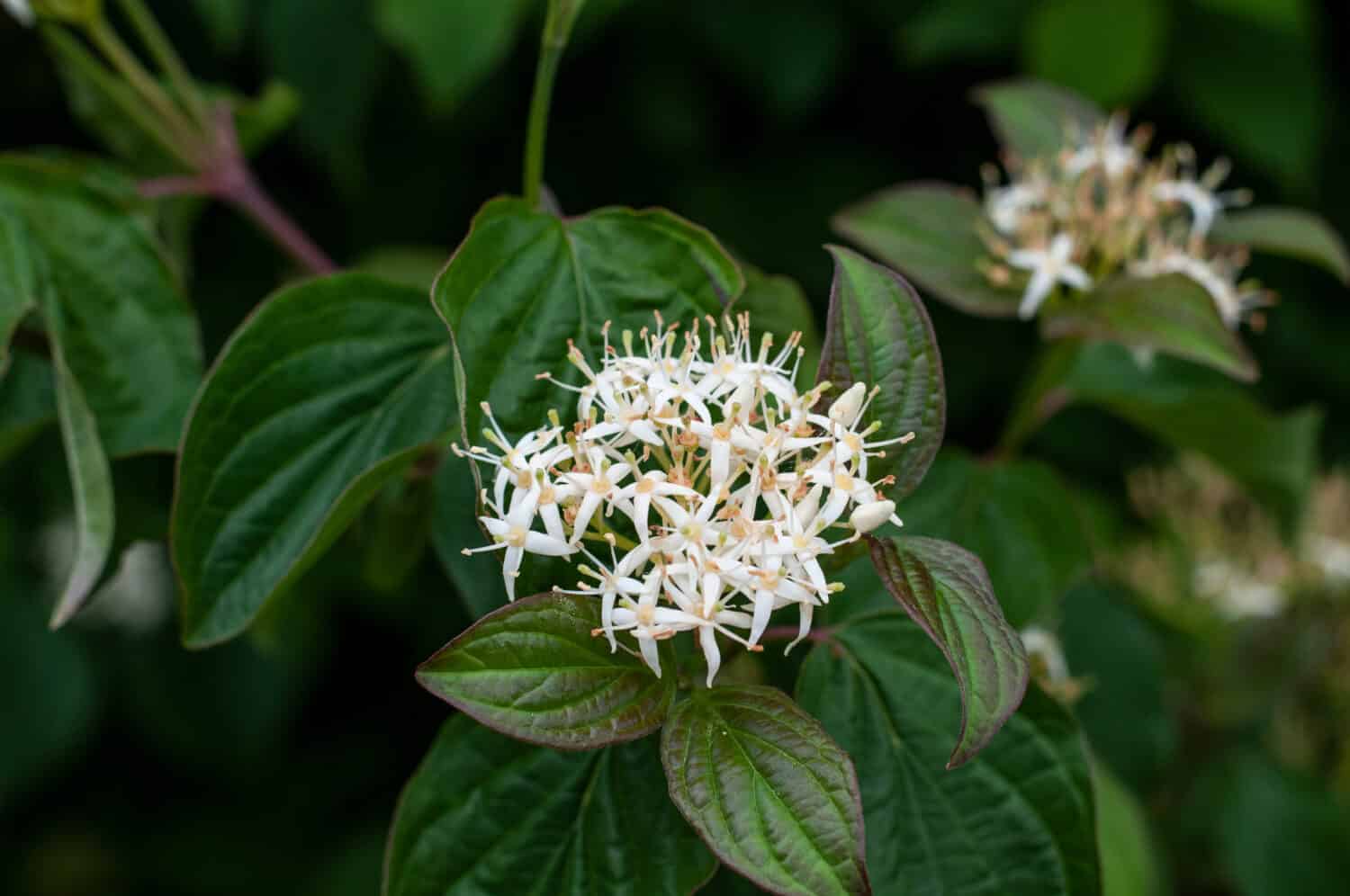
Rough-leaf dogwood thrives in shadier spots.
Image: Carmen Hauser, Shutterstock
©Carmen Hauser/Shutterstock.com
If you don’t mind textured leaves, then the Rough Leaf Dogwood is a perfect plant choice. This Dogwood requires shadier spots to flourish well. But, if you want your Dogwood to flower and bear fruits, expose it to sunlight.
The plant grows to 6 to 15 feet and is common in Eastern North America. Ensure your space is moist. But, rough leaf plants can tolerate dry conditions after they grow fully. They produce fruits in summer, and the foliage gets a reddish tint in fall.
8. Brown Dogwood
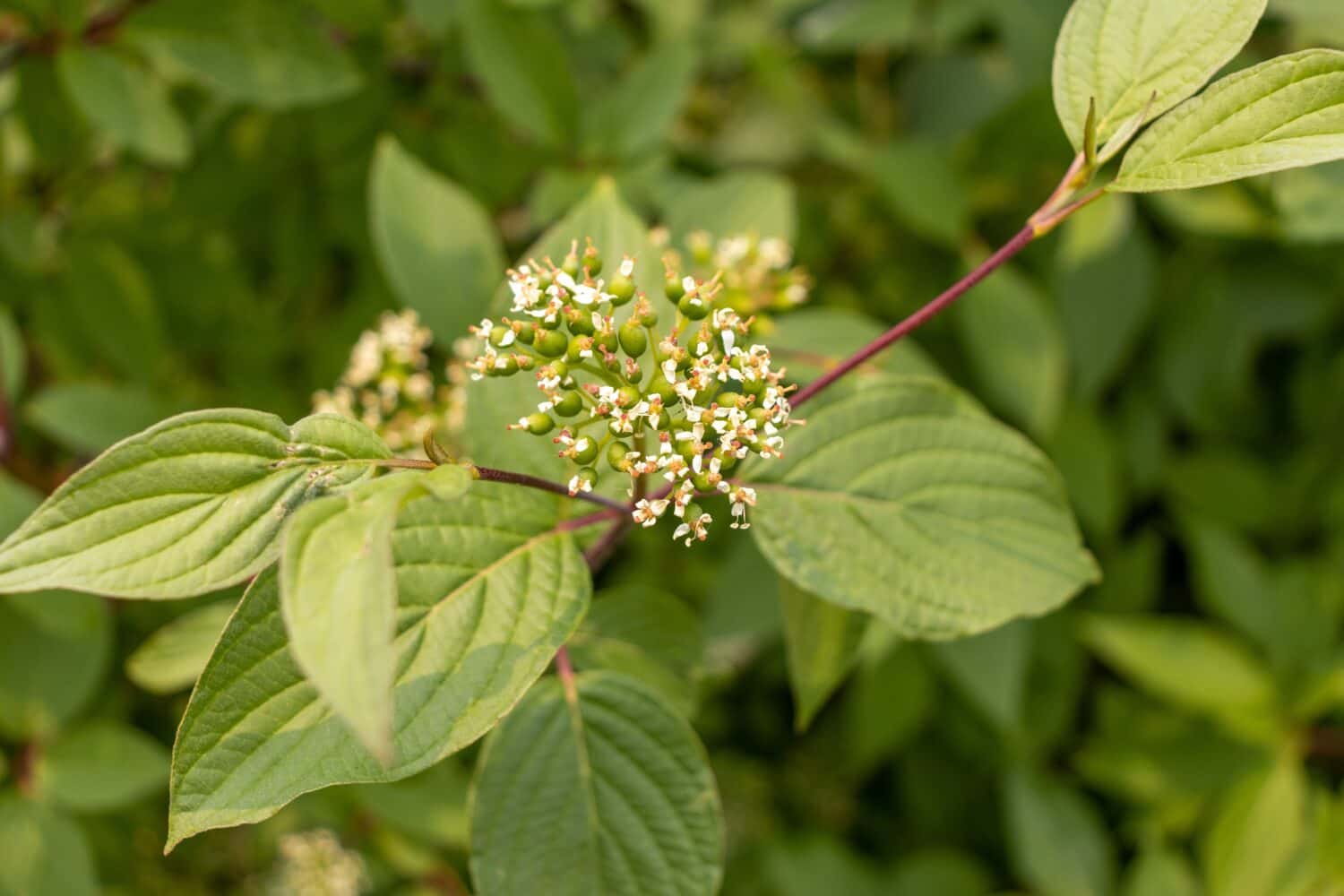
The brown dogwood bears blue fruit.
Image: Jacob Tian, Shutterstock
©Jacob Tian/Shutterstock.com
If you don’t fancy the texture of the leaves in the Rough Leaf Dogwood, here is an alternative. The Brown Dogwood is also known as smooth Dogwood. It is a shrub plant that thickens to block the way for people and animals to pass through.
The plant has a colorful red-brown bark, and its green leaves turn red in autumn and white in spring. The Brown Dogwood bears blue fruits.
9. Red Twig Dogwood
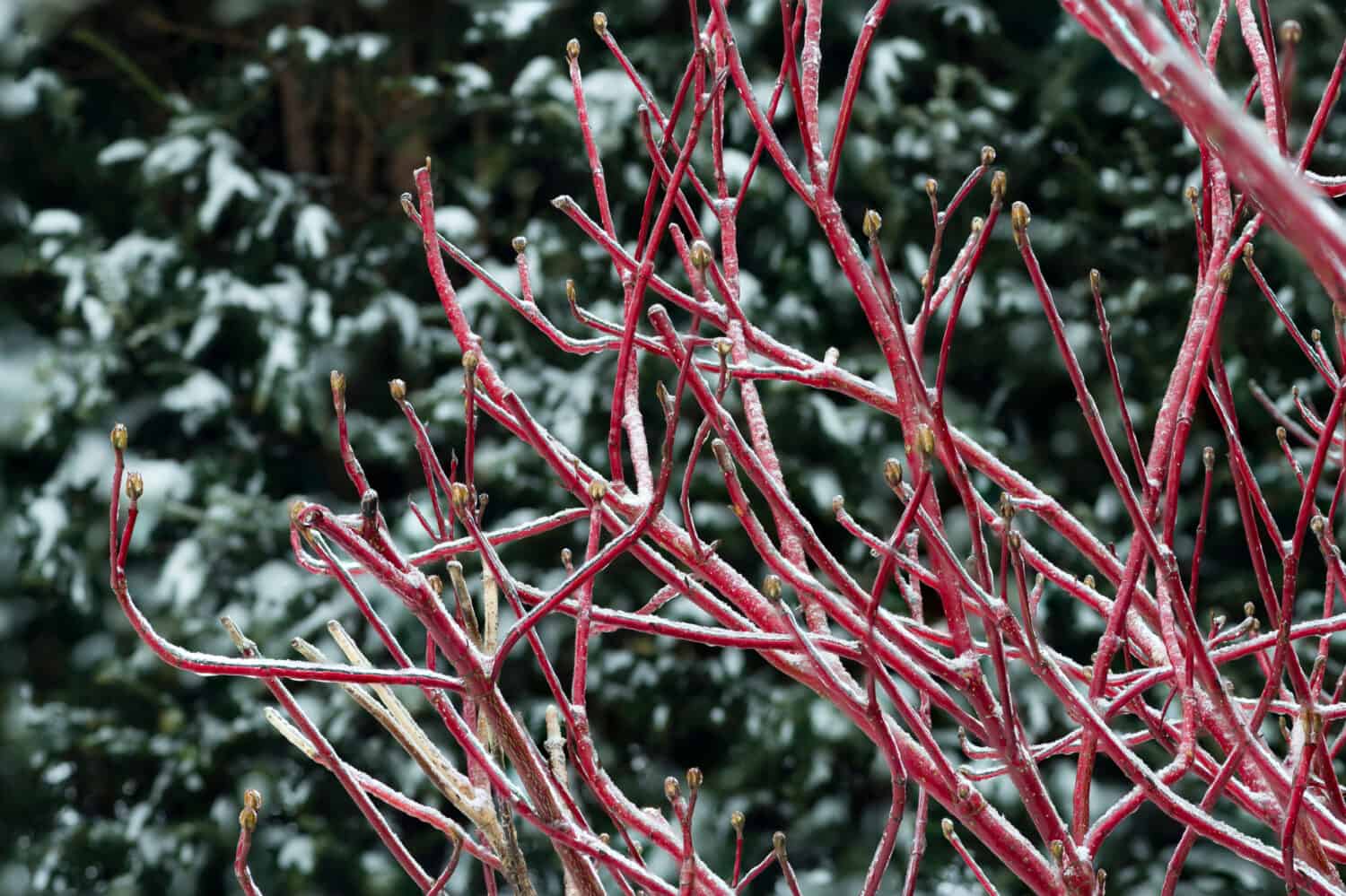
The red twig dogwood stems turn red at the end of summer.
Image: Mark Heighes, Shutterstock
©Mark Heighes/Shutterstock.com
Also called the Red Osier Dogwood, this Dogwood plant stands out from the rest. It has stems that turn red at the end of summer and some part of fall. The red is brighter in winter, and the stems retain their green color in winter.
The Red Twig Dogwood grows to a height of 7 to 9 feet and is mainly grown in North America. The plant produces tiny flowers that become purple during fall and grow into white berries that are attractive to birds.
10. Swedish Cornel
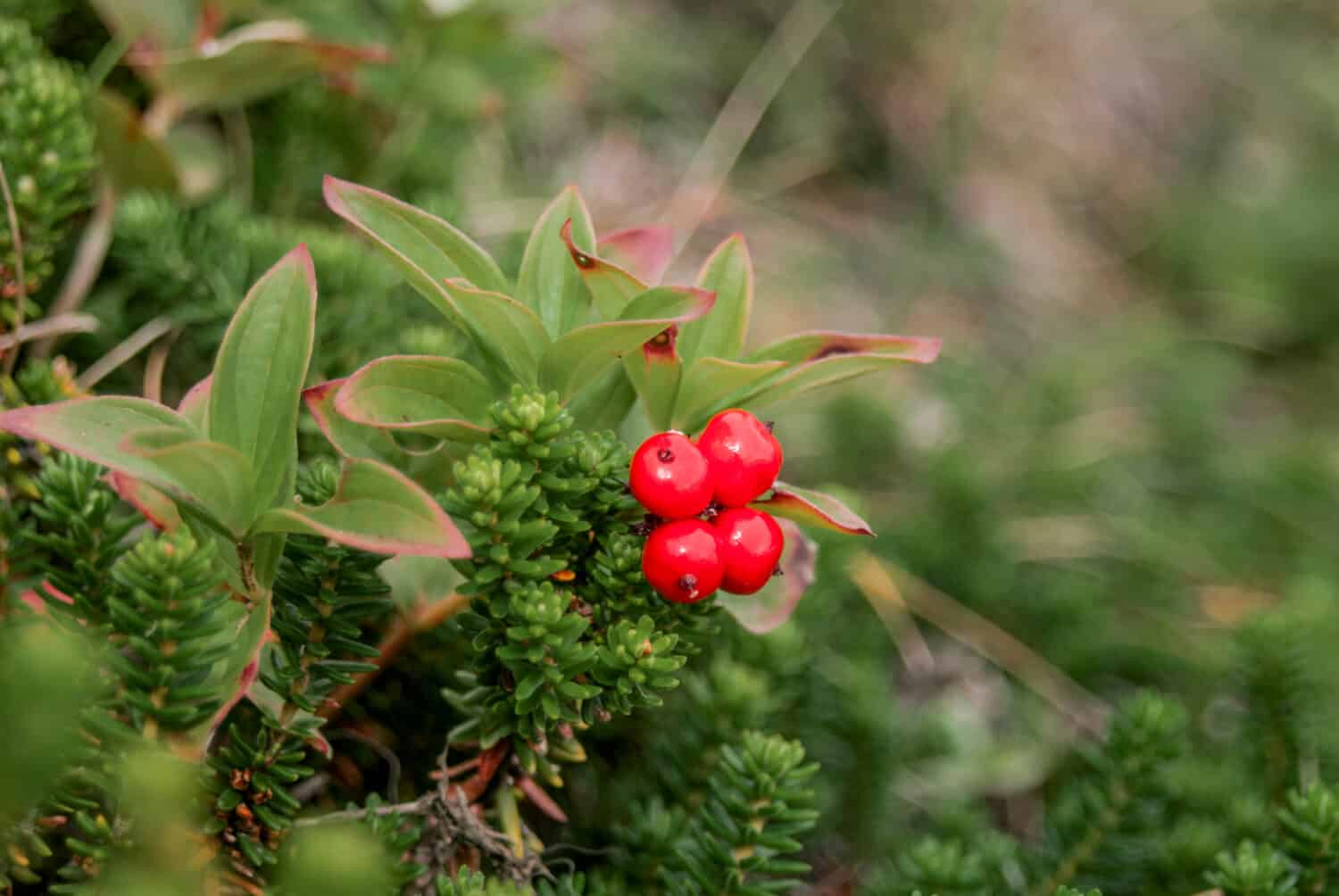
This subshrub produces purple flowers and grows to one foot tall.
Image: Nick Pecker, Shutterstock
©Nick Pecker/Shutterstock.com
If you want a not-so-tall Dogwood that grows up to 1 foot tall, get the Swedish Cornel. It is a subshrub and produces dark purple flowers. The best environment to grow this shrub is in wet environments, and it is common in Europe, Asia, and North America.
Conclusion
Whether you want your Dogwood short, about a foot tall, or 15 feet tall, you can always get one that meets your needs. These plants also produce flowers and fruits, although some fruits are not edible.
Bonus: Benefits of Planting Dogwoods
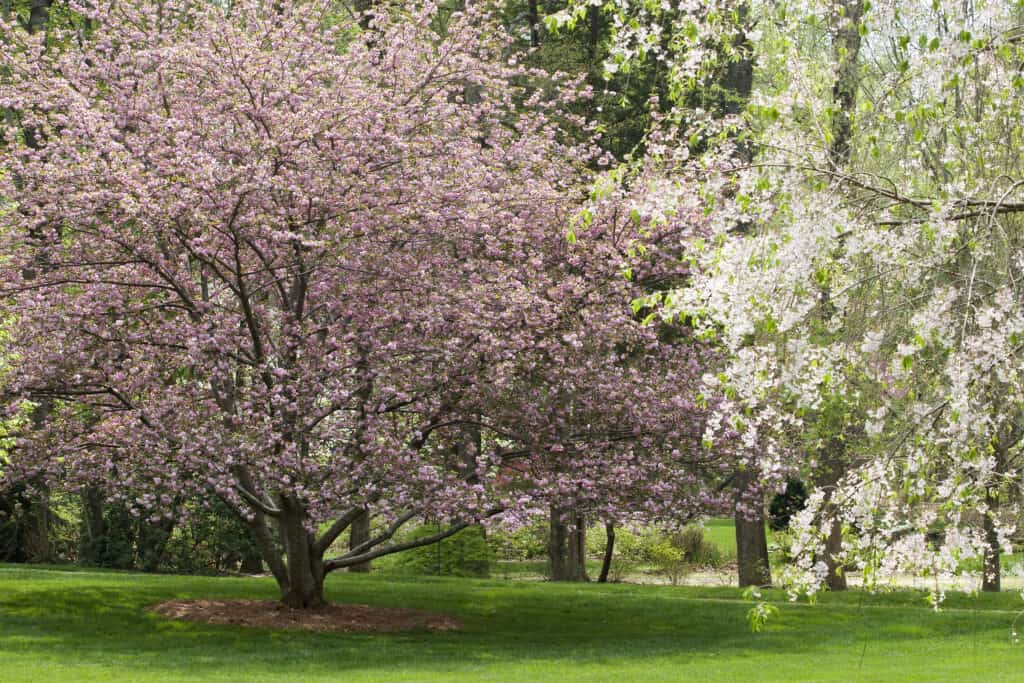
Dogwood trees are gorgeous when in bloom.
©iStock.com/JillLang
Chances are, at least one of your neighbors has planted a dogwood in their yard – and you have admired it. After reading this article you may be considering planting one yourself! Dogwoods are popular for many reasons. Here are some of the benefits of having a dogwood tree in your garden:
- Dogwoods flower profusely in mid-spring. The lovely blossoms resemble Japanese cherry trees.
- Blooming dogwoods attract pollinators. The beautiful blossoms are rich in nectar to attract bees, butterflies, and hummingbirds. The insects attracted to the blooms attract birds. Dogwood berries bring squirrels, rabbits, deer, and even more birds to your garden.
- They put on a lovely display for every season. From their glossy green summer leaves to the purple-red leaves of fall – dogwoods never cease to delight. Fall’s little crimson berries give way to the stark beauty of the tree’s bark and branches in winter before blossoms take the stage in spring.
- Propagation is easy. Even inexperienced gardeners can create as many trees as they like from cuttings.
- Dogwoods don’t need a lot of space. Topping out at 20 feet in height – these lovely trees have a smaller canopy and shallow roots. They can be planted close to your house without their roots damaging your house.
- They are low maintenance. All you have to do is remove dead branches and add mulch to the base of the tree in the fall.
Summary of the 10 Different Types of Dogwood Trees
| Dogwood Type | Description | |
|---|---|---|
| 1 | Canadian Bunchberry | Dark green leaves with prominent veins, white flowers |
| 2 | The Common Dogwood | White flowers on multiple stems, leaves are elliptical to oval in shape |
| 3 | Flowering Dogwood | Red, white, or pink flowers on low branches |
| 4 | Cornelian Cherry | Yellow flowers turn into edible cherries |
| 5 | Gray Dogwood | Dark green leaves with white flowers that turn to berries |
| 6 | Pagoda Dogwood | Lacey white flowers on alternately arranged leaves must be pruned with care |
| 7 | Rough Leaf Dogwood | Textured leaves and flowers turn to fruit in the summer |
| 8 | Brown Dogwood | This dense shrub is often used as a barrier, produces blue berries |
| 9 | Red Twig Dogwood | Tiny purple flowers turn to white berries |
| 10 | Swedish Cornel | A subshrub with dark purple flowers |
The photo featured at the top of this post is © iStock.com/JillLang
Sources
- My Decorative Decor and Design Online Magazine, Available here: https://mydecorative.com/everything-you-need-to-know-about-dogwood-trees/
- Perfect Plants, Available here: https://myperfectplants.com/blogs/grow-guides/how-to-grow-a-dogwood-tree
- Gardening Know How, Available here: https://www.gardeningknowhow.com/ornamental/trees/dogwood/common-dogwood-varieties.htm
- Worst Room Home Design, Available here: https://worstroom.com/types-of-dogwood-trees/
FAQs (Frequently Asked Questions)
Where do Dogwood trees grow?
It’s best to plant a Dogwood tree in full sun or partial shade.
Can I plant a Dogwood tree near my house?
No matter what type of Dogwood tree you choose to plant, it’s a good idea to choose a location at least 15 feet away from your house so that the tree can fully grow.
Do Dogwood trees have big roots?
Dogwoods have shallow roots, which usually dry quickly.
Thank you for reading! Have some feedback for us? Contact the AZ Animals editorial team.






